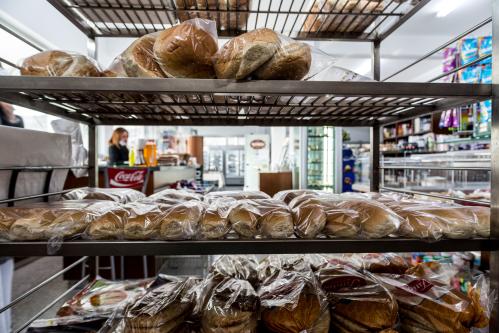As the old adage goes, all good things come to an end. Gone are the days of low inflation and easy global financial conditions. Many emerging market and developing economies (EMDEs) have recently been experiencing an unpleasant combination of elevated inflation and rising borrowing costs. At 8.5 percent in March 2022, inflation in EMDEs has reached its highest level since 2008 (Figure 1). In advanced economies, inflation is now at its highest level since 1991. Global financing conditions are tightening, as major advanced economy central banks are expected to raise policy interest rates at a faster pace than previously anticipated to contain inflationary pressures.
Figure 1. Consumer price index inflation, 1990 – 2022
 Sources: Ha, Kose, and Ohnsorge (2021); World Bank.
Sources: Ha, Kose, and Ohnsorge (2021); World Bank.
Note: Last observation is March 2022 and includes year-on-year group median inflation for 81 countries, of which 31 are advanced economies and 50 are EMDEs.
Amid deteriorating growth prospects, EMDEs will likely continue grappling with elevated inflation and more expensive borrowing terms. To cope with high inflation and borrowing costs, policies in these economies will require careful calibration, credible frameworks, and clear communication. This is easier said than done, especially when fiscal space is limited and financial vulnerabilities are prominent. However, sticking to certain principles of policymaking can pay large dividends in making these economies more resilient as they navigate uncharted waters.
Monetary policy: Tighten with care
For monetary policy, calibrating policy levers within a clear and predictable framework to get ahead of inflation without stifling the recovery will be key. Many EMDEs had already started tightening monetary policy well before the war in Ukraine to stem inflation pressures. The average policy rate in EMDEs is now higher than the average during the 2010s (Figure 2).
Figure 2. Monetary policy rates in EMDEs, 2019 – 2022
 Sources: Bloomberg, Haver Analytics, World Bank.
Sources: Bloomberg, Haver Analytics, World Bank.
Note: Sample includes 22 EMDEs and nominal policy rates using real GDP as weights. Last observation is March 2022.
Going forward, communicating monetary policy decisions clearly, leveraging credible monetary frameworks, and safeguarding central bank independence will be critical to manage the cycle in these economies. To reinforce the anchor of low inflation expectations, policymakers need to communicate efficiently—not only with financial markets but also with households and firms.
Financial policy: Contain risks
On the financial side, policymakers need to rebuild reserve buffers and realign prudential policy to prepare for possible financial stress. During the pandemic, at least three-fourths of EMDEs implemented regulatory forbearance measures to prevent a credit crunch. Many governments supported lending to firms to address liquidity constraints through loan guarantees and payment moratoria.
In light of these earlier interventions, banking system exposures to exchange rate and rollover risks need to be monitored carefully and, if necessary, mitigated through macro- and micro-prudential policies. Credit quality and nonperforming loans need to be reported transparently such that prompt corrective action can be taken. Banks’ capital and liquidity buffers need to be sufficiently sound to be able to absorb shocks. If deployed appropriately, reserve buffers can help stem temporary exchange rate pressures.
Fiscal policy: Commit to credible plans
Fiscal policy challenges have been building in many EMDEs. Fiscal positions deteriorated sharply in the pandemic, and these deteriorations have not been fully unwound by 2022. Despite a strong initial rebound in growth last year, EMDE fiscal deficits are still 1.1 percentage points of GDP wider than in 2019, and government debt is 10 percentage points of GDP higher (Figure 3). In part to contain the fiscal deteriorations, EMDEs already tightened fiscal policy in 2021, unwinding about one-half of the 2020 fiscal impulse.
Figure 3. Government debt and fiscal deficits in EMDEs, 2019 and 2022
 Sources: International Monetary Fund, Kose et al. (2021), World Bank.
Sources: International Monetary Fund, Kose et al. (2021), World Bank.
Note: Aggregates weighted with GDP in U.S. dollars for 152 EMDEs (government debt) and 155 EMDEs (deficit). LHS stands for left scale and RHS stands for right scale.
The pace and magnitude of further withdrawal of fiscal support must be finely calibrated and closely aligned with credible medium-term fiscal plans. Moreover, policymakers need to address investor concerns about long-run debt sustainability by strengthening fiscal frameworks, enhancing debt transparency, upgrading debt management functions, and improving the revenue and expenditure sides of the government balance sheet. Inflation expectations are unlikely to be well anchored if there are concerns about fiscal sustainability due to fears that monetary policy is constrained, especially in cases where high interest rates imply unstable public debt dynamics.
If the recent surge in energy and food prices persists, EMDE commodity exporters and importers will face diverging policy challenges. Commodity importers may need to contain inflation pressures, which could weigh on growth, while controlling challenges associated with fiscal and external imbalances resulting from high commodity prices. Commodity exporters may need to keep inflation in check amid strong growth on the back of rapidly expanding resource sectors. Some of the windfalls from higher commodity prices need to be invested to enhance long-term growth—including human capital—instead of being used for distortive energy subsidies.
Other interventions: Avoiding distortive measures
Export restrictions and disrupted global food markets due to the war are expected to contribute to rising global food inflation. The use of trade policy interventions and price controls to insulate domestic markets from food price shocks could compound the volatility of international prices and lead to even higher domestic prices. To address the volatility in food prices, EMDE policymakers need to strengthen social safety nets and enhance the resilience of food systems, while refraining from counterproductive price control measures. Price controls were pervasive in EMDEs even before the recent surge in commodity prices. These controls tend to distort markets and have adverse consequences for growth and poverty reduction, which often prove difficult to roll back after a crisis. If political considerations make price controls or untargeted subsidies unavoidable, their longer-term damage can be contained if they are introduced with automatic sunset clauses.









Commentary
Coping with high inflation and borrowing costs in emerging market and developing economies
May 5, 2022